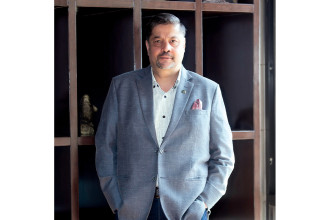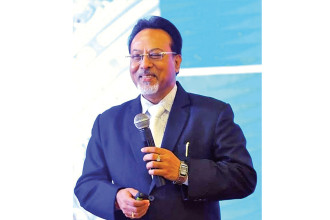-1749548151.jpg)
Neal Cross
Fintech Founder and Evangelist
Former Chief Innovation Officer, DBS Bank Singapore
Neal Cross stands at the intersection of finance, technology and transformative leadership. Best known for his role as the former Chief Innovation Officer at DBS Bank Singapore, one of the world’s most digitally forward financial institutions, Cross has built a reputation as a trailblazer who challenges conventional wisdom. With a background that includes key roles at Microsoft and his own entrepreneurial ventures, he brings a unique blend of Silicon Valley audacity and institutional discipline to the world of banking and fintech. His work has consistently centred on shifting mindsets within large organiations, helping them embrace innovation not just as a department but as a cultural foundation.
At DBS, Cross famously championed the idea that ‘the innovation group will invent nothing’, sparking a radical shift that empowered employees at every level to become innovators. His philosophy emphasises democratising innovation, fostering partnerships over ownership, and navigating regulatory landscapes not as hurdles but as creative constraints. These insights have had a lasting impact, influencing how banks across Asia approach digital transformation, especially in increasingly competitive and fast-evolving markets.
More recently, Cross has been engaging with fintech ecosystems in emerging economies, offering both inspiration and practical advice to startups and regulators alike. His visit to Nepal for the Nepal Fintech Festival 2025 was a testament to this ongoing commitment.
In Kathmandu, Business 360 caught up with Cross for a wide-ranging conversation about the future of banking, the opportunities for Nepali fintechs, and why innovation must be rooted in solving real problems. Excerpts:
You were the Chief Innovation Officer at DBS Bank which has a strong reputation for innovation. What were some of the biggest innovation challenges you faced in that role?
When I first took on the role, one of the first things I stated and it surprised many people was that the innovation group would never invent anything. That raised a few eyebrows. People would ask, ‘Well then, who are the innovators?’ And I would simply say, ‘You are’. My fundamental belief is that innovation cannot be centralised. Instead, it must be democratised. The role of the innovation group is not to create shiny prototypes in isolation but to empower every individual in the organisation to innovate in their own role. That is when transformation becomes sustainable.
Now, the challenges were plenty. Obviously, banks are complex organisations dealing with sensitive data and operating in heavily regulated environments. But if you ask me, the toughest challenge was not technological, it was cultural.
Banks are, by nature, risk-averse institutions. That risk aversion gets deeply embedded into the organisational culture, making it hard to foster an environment where experimentation is encouraged, and where small, safe failures are seen as part of the journey. My biggest task was to shift that culture, to get bankers to think more like startup founders, to embrace a mindset of continuous learning and calculated risk-taking. That was no small feat.
Banking is one of the most regulated industries in the world. How do you identify and nurture disruptive technologies in such an environment?
I think we need to flip the narrative around regulation. I actually like regulation. Constraints, when interpreted correctly, breed creativity. The real issue is not regulation itself but how banks interpret and implement it.
Regulators often draw a line, but banks fearing repercussions stay miles away from that line. Instead of engaging with regulators to understand the spirit and flexibility of the rules, they retreat. That is a missed opportunity. In fact, many regulators are actively encouraging innovation.
Take India, for instance. DBS was the first bank there to enable thumbprint authentication for account openings using the Aadhaar biometric system. At the time, other banks thought the regulators would never allow it. But we engaged proactively with the regulators, had extensive discussions, and eventually got the green light. That gave us a first-mover advantage in a highly competitive market.
Moreover, regulators are increasingly creating frameworks like sandboxes to allow fintechs and banks to co-innovate in controlled environments. So, again, it is not about bending the rules, it is about understanding them deeply and working collaboratively to push the boundaries in safe and meaningful ways.
You have worked in both tech companies and financial institutions. How do their approaches to innovation differ?
Having spent time in companies like Microsoft before joining DBS, the contrast was stark. There are three fundamental differences between tech and bank cultures that I observed.
First, hierarchy. Tech companies often operate with flat structures. At Microsoft, I could freely share ideas, even disagree with senior leaders multiple levels above me without fearing backlash. Banks, on the other hand, are very hierarchical. There is a culture of deference. You do what the boss says. That stifles independent thinking.
Second, partnership models. In tech, partnerships are the lifeblood. Microsoft, Google, Amazon, they all rely heavily on ecosystems. Banks, however, tend to prefer ownership. They own their branches, ATMs, core systems, even the customer experience end-to-end. This makes them hesitant to collaborate with fintechs or external tech providers because they fear losing control.
And third, the build-versus-partner dilemma. Banks often say, ‘We can build that ourselves’. And yes, they can, but it will be more expensive, take longer and be less effective. They might build version 1 of a product and stop there, whereas a fintech company is focused on evolving that product 24/7. Their entire existence depends on making that solution better with every iteration. That kind of focus is hard to replicate internally.
Also, many banks have rigid procurement processes. At DBS, when I arrived, we could not work with companies that were not profitable or that had been in business for less than three years. That ruled out half the startups in the world. So, we had to overhaul our risk assessment processes to allow us to collaborate with promising early-stage fintechs. It required reengineering our own internal structures before we could genuinely innovate externally.
-1749548152.jpg)
You are in Nepal for a fintech event. What are your impressions of the country’s fintech ecosystem?
Honestly, I was blown away. The scale and professionalism of the event could rival similar ones in Singapore, London or New York. It was well-organised, well-attended and buzzing with energy. What struck me most was how collaborative the community is. The banks seem to get along. The fintech associations, like Fintech Kathmandu and Fintech Nepal, are doing a phenomenal job of bringing people together. That is rare.
In many countries, you see a lot of internal competition and fragmentation in the ecosystem. But in Nepal, there is a sense of shared purpose. That is a huge natural advantage. It might not seem like a big deal to insiders but from an outsider’s lens, trust me, it is significant.
Also, like many emerging markets, the fintech evolution seems to be starting with payments – QR codes, digital wallets, etc – and will gradually move up the value chain into lending, insurance, wealth management, corporate banking and even full digital banks over time.
Given that digital infrastructure in Nepal is still evolving, what are the top three priorities you would recommend to accelerate fintech adoption?
Whether you are looking from the consumer side or the institutional side, there are a few key priorities. The first thing one needs to do is build trust. Consumers will adopt better, cheaper, faster products but only if they trust them. That is why fintechs need to invest heavily in transparency, security and user experience. It takes time to build that level of trust but once it is there, adoption accelerates rapidly.
The other is to enable bank-fintech collaboration. Banks need to be empowered to go more digital and collaborate more openly with fintechs. This involves internal changes, as we discussed earlier, particularly in procurement, compliance and cybersecurity processes.
Lastly, I would stress licensing flexibility. Regulators should consider enabling new types of licences that allow fintechs to serve the underserved, particularly in micro-lending and financial inclusion. Fintechs can often reach the base of the pyramid in ways that traditional banks cannot but they need the regulatory headroom to do so.
As someone who has worked at Microsoft and DBS, and is now an entrepreneur, what advice would you give Nepali fintech startups to attract global partnerships and investments?
The number one thing is: solve a real problem. Too many startups fall in love with their idea rather than the problem it solves. Before building anything, ask: Is this desirable? Do people truly want this? Is it feasible? Can you build and scale it reliably? And is it viable? Does the business model make sense long-term?
When it comes to investors, especially venture capitalists, understand their language. Learn how to pitch. Know what a good pitch deck looks like. Be ready to explain your flywheel, that is, how growth in one part of your business feeds into and strengthens other parts, creating a self-sustaining loop.
Also, know your audience. Some venture capitalists focus only on certain sectors – B2B, B2C, e-commerce, etc. Others specialise in different growth stages – seed, Series A, Series B, and so on. For a country like Nepal, also look into impact-oriented funds like the Asian Development Bank. There are funds specifically designed to support emerging market innovations.
And finally, if you are using AI or other advanced tech, make sure you are not just plugging in a commodity API. Build something unique, your own intellectual property. That is what excites investors.
Looking at Southeast Asian countries, their financial technology seems far more advanced than Nepal’s. What can Nepal learn from those countries? You have worked in Singapore; what insights can you share?
At this stage in Nepal’s fintech development, there is no shame in borrowing ideas. In fact, it is smart business. In the startup world, truly original ideas are incredibly rare. More often than not, when someone tells me, ‘This is unique’, I say, ‘You have not done enough research’. If you can identify a model that has been successful in another geography, say in Southeast Asia or Africa, and has not yet been implemented here, you could save a huge amount of time and resources. You are not starting from scratch. You avoid costly mistakes because you already know what works and what does not.
That said, localisation is crucial. Regulatory environments, consumer behaviours and competition differ. You cannot just do a copy-paste. You need to take the core idea and adapt it to Nepal’s specific context.
Let me give an example. In the Philippines, I have worked on lending platforms that provide small-ticket loans to rural women who do not have bank accounts. These loans help them start small shops or local enterprises. This model could work beautifully in Nepal as well, especially with backing from development banks or NGOs. With the right scale and support, this approach can genuinely uplift communities.
But you also have to look at broader trends. Over time, we expect that more people in Nepal will get access to the internet, smartphones and gradually improve their incomes. That is the arc of development. The challenge and the opportunity are to build financial tools that are safe, low-cost and tailored for this rising demographic.
Financial education, too, plays a massive role. Especially for those who are just entering the formal economy, understanding savings, micro-investments and even micro-insurance can be transformational. We have seen that women, in particular, are more disciplined savers. Teaching people how to build and preserve wealth, even in small amounts, can have a cascading effect. Ultimately, the goal is to lift the base of the economic pyramid. As the base rises, so does everyone else.
-1749548151.jpg)
From your perspective, what are the key fintech trends that Nepali entrepreneurs should be paying close attention to?
One word: gaps. Look for the gaps. If I were a fintech entrepreneur in Nepal, I would start by mapping out the existing fintech landscape. Who is doing what? What sectors are saturated? Then I would look for the areas no one is paying attention to. That is where the real opportunity lies.
You do not need to go head-to-head with a dominant player unless you have serious capital. Instead, offer the same product to a different segment or geography. Many of the bigger players are chasing high-revenue markets and often ignore underserved areas like micro-SMEs.
For example, banks traditionally overlook tiny enterprises or individual service providers. Can you provide them with micro-loans or custom insurance? What about rethinking investment products so people can invest as little as a dollar?
Fintech does not always have to be B2C either. In fact, B2B can be just as powerful. Think of the banks themselves. They have money but often outdated tech. If you can solve a problem for a bank, something they would rather outsource than build themselves, you have got a business. Build that solution and sell it to ten banks. That is perfectly viable and scalable.
Also, stay alert to regulatory changes. For example, open banking is gaining traction globally and across Asia. When it hits Nepal, fintechs that are ready for it will be miles ahead. Think: What will open banking mean for customers, regulators, and financial institutions? Where will the friction points be and how can you be the one solving them?
How do you see artificial intelligence and blockchain shaping the future of banking and fintech in Nepal and the region?
These two technologies are often spoken about together but they are very different beasts. Blockchain, despite the hype, is still mostly in prototype stages outside of crypto. After over a decade, its real-world applications in mainstream financial services are still limited. That is not to say it is useless, far from it. There is potential in areas like fractional bonds and digital asset tracking but I would say blockchain is still more of a ‘watch this space’ technology.
AI, on the other hand, is already rewriting the rules. Take customer service. There is a fintech in the Nordics using a GPT-powered AI agent that handles the work of 600 employees across 32 languages. That is not hypothetical, that is happening now. Credit scoring is another frontier. Traditional models are slow, costly and often biased. AI-based credit scoring is faster, more accurate and can bring more people into the formal financial system.
Then there is the entire bank operations layer. Right now, banks rely on human teams to bridge gaps between systems – paper forms, manual data entry, internal workflows. AI can handle that, making banks leaner and freeing up staff for revenue-generating roles instead of operational grunt work.
Cybersecurity? That’s becoming an AI arms race – your bank’s AI fighting off malicious AI attacks in real-time. And just to name a regional best practice, I often use OCBC Bank in Singapore as a case study. Their AI systems make about 10 million customer decisions a day. They have integrated AI across risk, operations and customer journeys in a way that is seamless and hugely effective. AI reduces risk, cuts costs and boosts revenue. It is not a question of if, it is a question of how soon.
What policy recommendations would you offer to Nepal’s financial regulators and government bodies to promote innovation while still protecting consumers?
First, and this might sound blunt – just copy. Nepal’s regulators do not need to reinvent the wheel. Other countries have already tested regulatory frameworks, made mistakes and learned from them. Look at Singapore’s MAS (Monetary Authority of Singapore), the UK’s Financial Conduct Authority, or even India’s Reserve Bank of India in some areas. Their policies can offer a strong starting point. You will obviously need to localise some aspects but do not waste precious time or resources trying to build everything from scratch.
Start with future-casting. What kind of financial ecosystem do you want to see in five, ten years? What problems need solving, be it financial inclusion, savings habits, or pension planning? Chart that out and reverse engineer your regulatory path.
Also, hire talent from the fintech world. My good friend, Sopnendu Mohanty, recently stepped down as Chief FinTech Officer at MAS. His role was vital in shaping Singapore’s fintech ecosystem. Nepal should consider a similar position, someone from the trenches who can liaise between startups and the state.
Another practical step is to enable digital onboarding. Can a person in Nepal open a bank account entirely on an app? If not, that needs to change. Digital ID and digital KYC are game-changers. Set up regulatory sandboxes – controlled environments where fintechs can test new ideas without needing a full licence. Regulators can observe, learn and then decide how to shape formal policy. It also shows startups that you are willing to work with them.
One word of caution though is you must balance openness with protection. Do not let foreign companies dominate the sector at the expense of local innovators. Foreign players can add value but the ecosystem should be designed so that Nepali companies lead and others complement.
What is your message to aspiring fintech entrepreneurs and policymakers in Nepal?
Do not be afraid to learn from others but always think locally. Innovation does not have to mean inventing the next Bitcoin. It can mean tweaking an existing model to fit your culture, your infrastructure and your people. Nepal has immense potential. As more people get connected, as incomes rise, as financial awareness grows, the market will open up. But the groundwork must be laid now.
Look for gaps. Listen to your users. Partner with the right institutions. Leverage AI smartly. And regulators, please, work with innovators, not against them. Fintech can be a powerful tool not just for profit, but for upliftment. If we build right, we can bring more people into the financial system, help them save, grow and secure their future. And that, to me, is the most meaningful return of all.
Any final thoughts on the future of banking and fintech innovation?
Innovation is no longer a luxury in banking, it is a necessity. The institutions that will thrive are the ones that understand this is not just about technology. It is about mindset. It is about empowering people. It is about building partnerships and shaping ecosystems. Whether in Singapore, Silicon Valley or Kathmandu – the future belongs to those who can adapt, collaborate and evolve.






